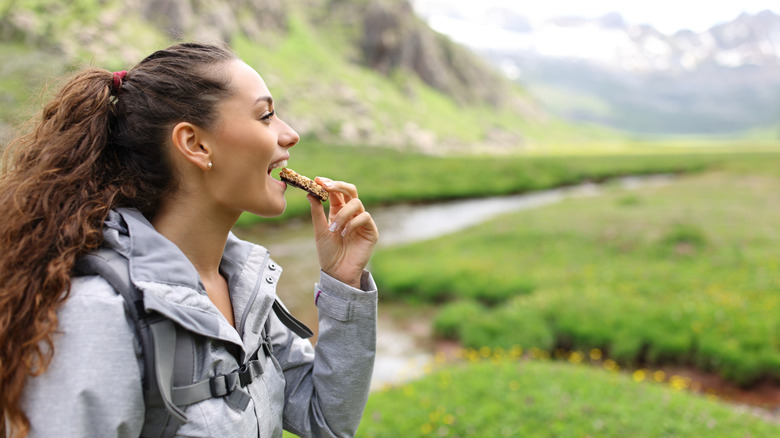
There are plenty of safety tips to follow before taking your first solo hike, such as knowing the route and shopping for the proper-size hiking boots. One rule that often seems to get glossed over is fueling up with the right nutritional foods. When you don't eat right while on the trail, you might suffer the consequences. Hikers call this "bonking," and it's basically equivalent to the phrase "hitting a wall," when there is an extreme drop in energy and your body fights to continue the hike.
Bonking
is typically caused by the depletion of glycogen, which is the body's main source of stored energy derived from carbohydrates. It can feel like sudden fatigue, dizziness, mental fog, irritability, or even a sense of despair. Your legs may feel heavy, your pace slows, and every step becomes a struggle.
If you're hiking solo, this can become a serious safety risk, especially if you're far from help or in difficult terrain. To prevent bonking, it's important to eat a balanced, carbohydrate-rich meal a couple of hours before your hike and bring portable snacks like trail mix, dried fruit, granola bars, or nut butter packets to eat along the way. Consistent hydration is just as vital; water and electrolyte drinks help keep your energy stable and your mind clear on the trail. However, preparation for a hike stretches further back than just a few hours. In most cases, it's best to start training days in advance.
Read more: The 5 Best Hidden Hot Spring Hikes In California
How To Prepare For A Hike And Prevent Bonking

Whether you're doing a small hike at a local park or going to a European country for an otherworldly trail, there are steps you can take to prepare your body for any trek, big or small. While many focus on building endurance, strength, and wearing the right gear, improper fueling can derail everything you've trained for. It's important to prep days in advance, not just the morning of your hike. Consuming balanced meals rich in complex carbohydrates, lean protein, and healthy fats supports glycogen storage, which fuels endurance activities and prolonged exercise.
While hikers are properly fueling and getting ready for their next adventure, they can also gradually increase training intensity to help their muscles adapt to using and storing glycogen more efficiently. For more challenging hikes, strategically carb-load (consume more carbs than your body typically needs) to top off glycogen reserves. Finally, planning your trail nutrition and hydration strategy ahead of time ensures you won't miss critical fueling windows when out. By combining these habits with balanced meals and snacks, you'll be better prepared to maintain steady energy levels and enjoy your hike without the sudden energy crash known as bonking.
Ready to discover more hidden gems and expert travel tips? Subscribe to our free newsletter for access to the world's best-kept travel secrets.
Read the original article on Islands.










